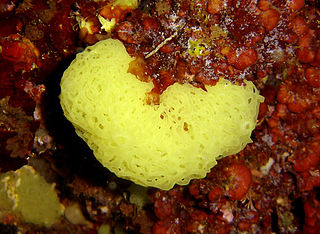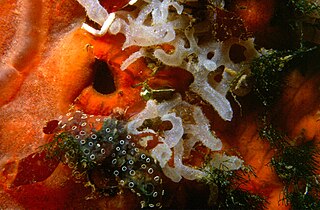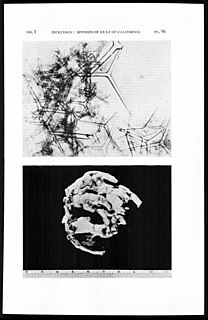
Clathrina is a genus of calcareous sponge in the family Clathrinidae. Several species formerly in Clathrina were transferred to the newly erected genera Arturia, Ernstia, Borojevia, and Brattegardia in 2013. The name is derived from the Latin word "clathratus" meaning "latticed".
Dendyidae is a family of calcareous sponges, which contains thirteen species in two genera.

Leucosolenia is a genus of calcareous sponges belonging to the family Leucosoleniidae. Species of this genus usually appear as groups of curved vases, up to 2 cm long, each ending in an osculum. The overall shape is sometimes likened to a tiny bunch of bananas. They are most often observed in tide pools, clustered around the base of seaweeds or on rocks, and occur in a variety of colours, usually rather pale. Its canal system is of asconoid type. The colony consists of few simple vase-like, cylindrical individuals each terminating in an osculum and united at their bases by irregular horizontal tubes. Leucosolenia reproduces both asexually and sexually. asexual reproduction by budding and sexual reproduction takes place by formation of gametes, i.e., ova and sperms. Lecosolenia is hermaphrodite, because both the gametes are formed in the body of same individual.

Grantia is a genus of calcareous sponges belonging to the family Grantiidae. Species of the genus Grantia contain spicules and spongin fibers.
Leucandra is a genus of calcareous sponge belonging to the family Grantiidae. Its earliest known fossils are from the Jurassic.

Sycon is a genus of calcareous sponges belonging to the family Sycettidae. These sponges are small, growing up to 7.5 cm and having length from 2.5 to7.5, and are tube-shaped and often white to cream in colour. They are known to aquarium hobbyists as "Pineapple" or "Q-Tip" sponges, and are frequent "hitchhikers" accidentally brought in.

Clathria is a large genus of demosponges in the family Microcionidae.
Homaxinella is a genus of sea sponges in the family Suberitidae. The type species is Homaxinella balfourensis.

Myxilla is a genus of demosponge belonging to the family Myxillidae. These sponges usually form encrustations on rock surfaces.

Arturia is a genus of calcareous sponge in the family Clathrinidae which contains 14 species. It is named after Arthur Dendy, a prominent researcher of calcareous sponges. It was renamed Arturia in 2017 because the name Arthuria was already assigned to a genus of molluscs.

Gelliodes is a genus of sponges in the family Niphatidae.
Amphoriscus is a genus of calcareous sponges in the family Amphoriscidae.

Soleneiscus is a genus of calcareous sponges in the family Dendyidae.
Ascaltis is a genus of sponges in the family Leucascidae, first described in 1872 by Ernst Haeckel.

Leucetta is a genus of sponges in the family Leucettidae, which was first described in 1872 by Ernst Haeckel. The type species is Leucetta primigenia Haeckel, 1872 by subsequent designation.
Vosmaeropsis is a genus of sponges in the family, Heteropiidae, and was first described in 1893 by Arthur Dendy. The type species by subsequent designation is Vosmaeropsis macera.
Leucaltis is a genus of sponges belonging to the family Leucaltidae.

Iophon is a genus of sponges belonging to the family Acarnidae. The genus has a cosmopolitan distribution.
Fibulia is a genus of sponges belonging to the family Dendoricellidae. The species of this genus are found in Southern South Hemisphere.

Latrunculia is a genus of demosponges. It is well known for the diverse array of chemical compounds found in its species, including the latrunculins, which are named after this genus. Many of these are medically important, including anti-cancer compounds such as discorhabdins.












